Math Mammoth Blue Series
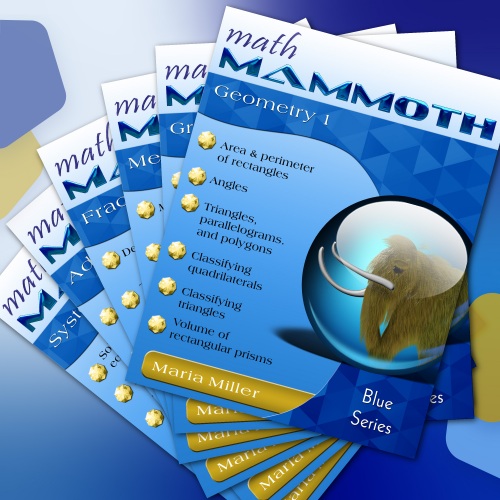
Math Mammoth Blue Series books are worktexts or units on specific math topics for grades 1-8.
A worktext means that each book includes both the explanations of the concepts and lots of varied problems. Thus, these books combine the textbook and workbook into one.
Each book in the series concentrates on a few topics only, such as addition & subtraction, place value, clock, measuring, money, multiplication, division, geometry, fractions, decimals, ratios, percent, integers, and so on.
This topical arrangement makes the books suitable for many situations, such as:
- To supplement any other math curriculum;
- As a remedial material for students who are behind;
- As a review material on specific topics.
The video below explains the basics of the Blue Series books:
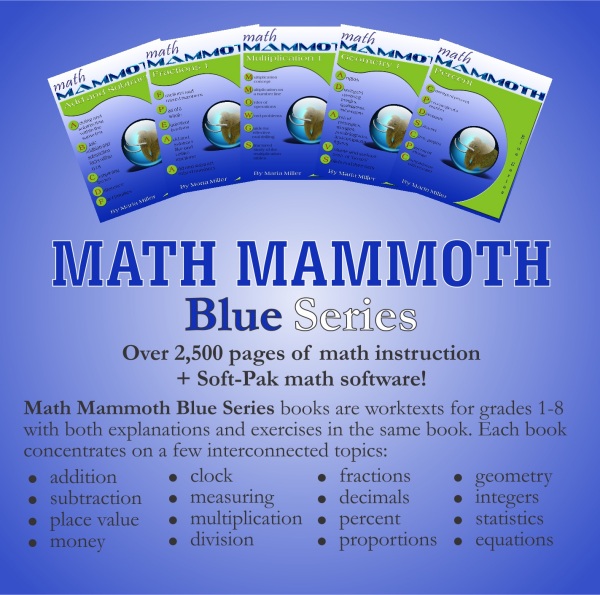
Blue Series BUNDLE deals
ALL the books in the Blue Series at 33% off!
Price: USD $165 (download)
Blue Series bundle for grades 1-3
Learn more
Price: USD $49 (download)
Blue Series bundle for grades 4-5
Learn more
Price: USD $47 (download)
Blue Series bundle for grades 6-8
Learn more
Price: USD $69 (download)
You will be purchasing the items from my authorized reseller Comecero, LLC.
The Blue Series books are very affordable as downloads: the prices vary from $2 to $9.00. You can purchase them as downloads...
- at this website, and
- at K5Learning Store
...and as printed copies (paperbacks) at
- Lulu — follow links to Lulu from the pages for individual Blue Series books on this site
The books in the Blue Series cover all math topics for grades 1-8. Please click here for a suggested order of study and grade-level matching for the books.
The downloadable versions (PDFs) are enabled for annotating. This means that the student can complete the PDF file on the computer, using the comment tools available in Acrobat Reader version 9 or higher, or on a tablet device using a PDF app that has annotating tools.
It is even possible to use the Blue Series books as a complete math curriculum; however, it will take more planning work than using the Light Blue series. It is a cheaper option though and some people do use it as such. If you do decide to use the Blue Series as your main math curriculum, then I recommend you also check out this series of review workbooks to provide your student with mixed review lessons.
These books are also available as Spanish versions, which is very useful for English language learners (ESL, EEL, ESOL students). The students can use both the English and Spanish books (Math Mammoth and Mamut Matemáticas) as their math curriculum. If they cannot understand the English version, they can check the corresponding book in Spanish and understand the math from there — and also learn English at the same time.
A List of Blue Series books
The grade-levels mentioned are recommendations only. The books themselves do not mention any grade levels and are usually usable across several grade levels.
Addition and subtraction books
Addition 1 — grade 1. Addition within 0-10, missing addend problems (2 + ___ = 8), word problems.
Subtraction 1 — grade 1. Basic addition and subtraction facts within 0-10, difference, "more than", word problems.
Add & Subtract 2-A — grades 1-2. Basic addition and subtraction facts within 0-18, strategies for adding and subtracting within 0-20; word problems.
Add & Subtract 2-B — grade 2. Mental math strategies for adding and subtracting two-digit numbers. Regrouping (carrying) in addition is initially explained in this book, with the help of visual models.
Add & Subtract 2-C — grade 2. Regrouping in addition (3-digit) and subtraction (2 and 3-digit), with the exceptions of regrouping over zeros and regrouping twice in subtraction.
Add & Subtract 3 — grade 3. Adding and subtracting within 0-1000, both with mental math and in columns, regrouping over zeros and regrouping twice in subtraction, rounding, checking your answers.
Add & Subtract 4 — grades 3-4. Adding and subtracting within 0-10,000 and lots of problem solving.
Place value books
Place Value 1 — grade 1. Tens and ones. This book uses a 100-bead abacus, a visual model of base-ten blocks, number lines and a 100-chart.
Place Value 2 — grade 2. Three-digit numbers, comparing, rounding.
Place Value 3 — grade 3. Four-digit numbers, comparing, rounding.
Place Value 4 — grade 4. Numbers till millions, comparing, rounding.
Place Value 5 — grades 5-6. Numbers up to trillions, rounding, calculator usage.
Word problems
Foundational Word Problems — grades 3-6. While this book is not technically part of the Blue series, I want to mention it here because many students need help with word problems.It is aimed to help students for grades 3 and above who have trouble with word problems and who may need to “go back to the beginning”, to learn to solve them.
Clock and money
Clock — grades 1-4. Covers reading the clock, elapsed time, and calendar.
Money — grades 1-3. Learn to count U.S. coins, count change, and solve problems.
(Canadian Money) — grades 1-3. Same as above for Canadian coins and bills.
(British Money) — years 2-4. Same as above for UK coins and notes (pounds and pence).
(Australian Money) — years or grades 1-3. Same as above but using Australian cents and bills.
(New Zealand Money) — years or grades 1-3. Same as above but using New Zealand cents and bills.
(South African Money) — grades 1-4. Same as above for South African cents and rand.
(European Money) — grades 1-3. Same as above for Euro coins and bills.
Measuring
Measuring 1 — grades 1-3. Teaches all measuring units in both customary and metric systems and some conversions. Lots of hands-on exercises with measuring cups, scales, and so on.
Measuring 2 — grades 4-5. Teaches all units in both customary and metric systems and conversions between them, including the usage of decimals and fractions with measuring units.
Metric Measuring 1 — grades 1-3. This book contains all the lessons from the Measuring 1 book (above) that deal with metric measuring units.
Metric Measuring 2 — grades 4-5. This book contains all the lessons from the Measuring 2 book (above) that deal with metric measuring units.
Multiplication and division books
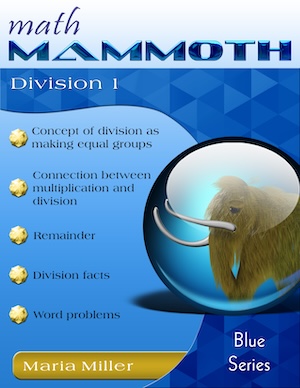
Multiplication 1 — grades 2-3. Multiplication concept, word problems, and a system to memorize the multiplication tables.
Division 1 — grade 3. Concept of division, basic division facts by one-digit numbers, remainder, word problems.
Multiplication 2 — grade 4. Multi-digit multiplication and problem solving.
Division 2 — grade 4. Long division, finding fractional parts of a quantity, and problem solving.
Multiplication & Division 3 — grades 5-6. Multi-digit multiplication and long division with larger numbers.
Factors & Factoring — grades 4-6. Divisibility, factors, primes, prime factorization, GCF, LCM.
Geometry & Statistics
Early Geometry - grades 1-3. Basic shapes and solids, symmetry, area, and perimeter.
Geometry 1 — grades 4-5. All basic geometry concepts for this level with lots of drawing-based exercises.
Geometry 2 — Grade 6. Area of triangles, parallelograms, and polygons; surface area and nets; and volume of rectangular prisms with fractional edge lengths.
Geometry 3 — Grade 7. Angle relationships, constructions, pi and the area of circle, slicing solids, volume of prisms
Geometry 4 — grade 8. Congruent transformations, dilations, angle relationships, volume of pyramids, cones, spheres, and cylinders.
Square Roots & the Pythagorean Theorem
Grade 8. Square roots, cube roots, irrational numbers, equations that involve roots, the Pythagorean Theorem, and its applications.
Data and Graphs — grades 2-5. Reading and making bar graphs, pictograms, line graphs, circle graphs; average (mean) and mode.
Statistics & Probability — grades 6-7. Distributions, histograms, stem-and-leaf plots, mean, median, mode, random sampling, comparing two populations, simple and compound probability.
Bivariate Data — scatter plots and two-way tables.
Fractions and decimals books
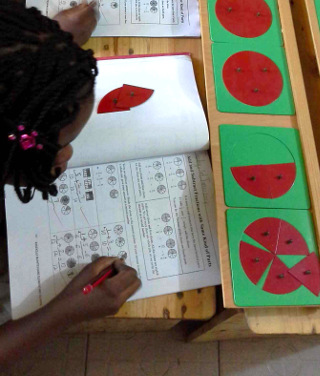 Introduction to
Fractions — grades 1-4. This book relies almost completely on visual
fraction models, and does not go into the most difficult fraction operations
such as adding unlike fractions or division.
Introduction to
Fractions — grades 1-4. This book relies almost completely on visual
fraction models, and does not go into the most difficult fraction operations
such as adding unlike fractions or division.
Fractions 1 — grade 5. The first half of fraction arithmetic: equivalent fractions, fraction addition and subtraction, comparing fractions -- all explained with the help of visual models.
Fractions 2 — grade 5. The second half of fraction topics, concentrating on fraction multiplication & division.
Decimals 1 — grades 3-4. Builds a solid foundation for the understanding of decimal numbers with 1-2 decimal digits and some of the basic operations with them.
Decimals 2 — grade 5. Explaining all of decimal arithmetic, especially the "tricky" decimal multiplication and division.
Fractions & Decimals 3 — grade 6. All of fraction and decimal arithmetic, with larger denominators in fractions and up to 6 decimal digits in decimals.
Ratios, proportions, percent & algebraic thinking
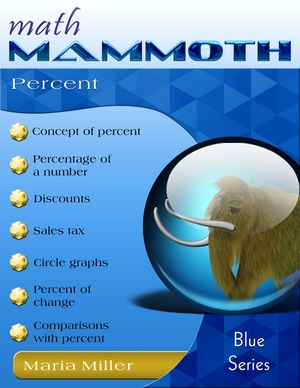 The Four Operations (with a Touch of Algebra) —
grades 5-6. Review of the four operations with whole numbers, order of operations, simple equations & expressions.
The Four Operations (with a Touch of Algebra) —
grades 5-6. Review of the four operations with whole numbers, order of operations, simple equations & expressions.
Ratios, Proportions & Problem Solving — grades 5-7. Ratios, proportions, scaling geometric figures, floor plans, solving problems using the bar (block) model: problems with fractional parts or ratios.
Percent — grades 6-8. Percent, percentage of number, discounts, sales tax, circle graphs, percent of change, percent of comparison.
Pre-algebra topics
Expressions & Equations — grades 6-7. The beginnings of algebra: expressions and equations on an easy level, without the usage of negative numbers
Integers — grades 6-8. Integers, addition, subtraction, multiplication, division, and coordinate grid problems.
Rational Numbers — grades 7-8. Arithmetic with negative decimals and negative fractions, complex fractions, and more.
Linear Equations 1 — grades 7-8. One-step, two-step, and multi-step linear equations.
Algebra topics
Exponents and Scientific Notation — grades 8-9. Negative and zero exponents, exponent laws, significant digits, scientific notation, using scientific notation in calculations.
Linear Equations 2 — grades 8-9. Multi-step linear equations, equations with fractions, word problems, number of solutions to an equation.
Introduction to Functions — grade 8. Concept of a function, rate of change, linear and nonlinear functions, modeling with linear functions, describing functions, comparing functions.
Graphing Linear Equations — grades 8-9. Comparing and graphing proportional relationships, slope, slope-intercept equation, horizontal & vertical lines, standard form, parallel & perpendicular lines.
Systems of Linear Equations — grades 8-9. Solving systems of linear equations by graphing, by substitution, or by the addition (elimination) method. Lots of word problems!
Bundle deals
- Get ALL 56 books in the Blue Series for a bundle price of $165 (download). This gives you over 2,700 (unique) lesson and practice pages. (I'm not including the variants of money books & metric easuring books in this count.)
Or, get the Blue Series books for grades 1-3 for only $49 (download). Learn more!
Or, get the Blue Series books for grades 4-5 for only $47 (download). Learn more!
Or, get the Blue Series books for grades 6-8 for only $69 (download). Learn more!
Partial FAQ
1. Is the Blue series a complete curriculum?
The Blue Series books have not been written to be a complete curriculum as such. Math Mammoth Light Blue series is the complete curriculum. The Blue Series does not contain tests or cumulative reviews, nor is it organized to go by grade levels.
However, it is possible to use the Blue Series books and "piece together" a math curriculum. This will cover all the necessary topics for grades 1-8.
Please keep in mind that many books in the Blue Series cover material for several grade levels in one book. The series is NOT organized exactly by grade levels.
2. Do all the workbooks come with answer keys?
Yes. All of the Blue Series books have answers appended in the worktext.
3. Can I buy the books as hardcopies (print versions)?
Yes. The Blue series books are available as printed hardcopies through Lulu.com.
4. In which order should I study the Blue Series books?
Please click here to read the answer.
5. Which book is right for my child?
You can usually find that directly from considering the math topic that your child finds difficult. Check the table of contents of the various books on that topic to find the best match. Or, check this table that lists the approximate study order and grade levels for the Blue Series books.
You can also have your child take a placement test for the Light Blue, email me the results, and I can guide you as to which Blue Series books would be best for your child.
Reviews & feedback
Math Mammoth Review — by Sabrina at KidsCrunchAndChrist blog.
Math Mammoth Blue Series Review — focusing on Data & Graphs, Statistics and Probability, and Expressions & Equations books.
Math Mammoth (TOS Crew Review) - Subtraction 1, Multiplication 1 by Minivan Moments blog
Thank you very much
John Vrakas
- Christie P., Co-op Member
October 2020
Because it is an important life skill, this summer we have really tried to focus on telling time and counting/understanding money. Your books are the first method that has ever worked for her. The breakdown, explanations, and practice have been just what she needed to finally be able to master these topics. Thank you for creating them and for keeping them so accessible and affordable!
Billi Jo
August 2019
Tanya G, Co-op Member
November 2018
Kind regards,
Gayla
January 2018
I find the way Math Mammoth teaches each concept to be easily accessible. There is enough visual support for my visual learner without the use of wild or distracting graphics such as I've seen in some other programs. The balance of new teaching and review practice seems right on. Math Mammoth Blue Series has made me better able to successfully teach math to my children, and in the process improves my own mathematical thinking. I'm simply thrilled with this program.
- Carly S.
September 2016
Thank you so much!
Rena
Zoe Caroll
- Peggy Dalley
Jennifer Bogart
"I LOVE YOUR PRODUCTS! Your approach to math is thorough and explicit -- simply great."
"...well set out, logical and easy to use..."
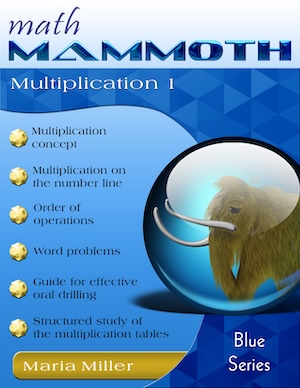
"It's working very well! ... We wanted something that worked according to the principle of mastery, which explained/demonstrated what was expected of the pupil, and assisted the parent in teaching. ... I love the way the pages are laid out - clear, attractive, appropriately colourful yet not cluttered and filled with distracting cartoon characters.
It's great value for money, and I love the ebook concept allowing us to print out the sheets we want, or the whole book according to what we need."
"I like their simplicity. They are cost effective and seem to have enough drill and practice."
"...they did all the teaching for me..."
"These books have allowed me to have more time with my family outside of work hours. The preparation of worksheets as you are aware are very time consuming and I have never found any books that have as much detail in explaning concepts and providing practice questions as your books do."
"...Very easy to follow, nice examples, nice mix of problems. Good flow for my kids' pace..."
"...I really like how easy these books make it to teach the kids their math. I also like that I have the ability to jump from grade to grade depending on where the kids need practice."
"...The format and content is very logical and clearly presented."
"These books have allowed for a lot of flexibility, yet they are well structured so you know they are learning and can track and grade their progress easily. Math isn't complicated, and I appreciate finding a resource that reinforces that concept to my children... and at a fantastic price too!"
"I also like the freedom it gives me to move around in the series if the student misses a vital step, going back to fill in what should have been learned but was missed - and doing that without the child feeling threatened with the shame of lower grade work since it is just the next page to him."
"I love the way a new concept is introduced and then practiced, practiced, practiced! My kids hated Saxon, because it would introduce a new concept, then only give them 5 problems to do to go with the new concept then the rest of the lesson was a review from previous lessons. By the next day, they forgot the concept that they had learned the day before and were really lost after having to learn a new concept that day."
The learning style is sequential and allows for various methods of finding the answer to the problem. The word problems require the child to use critical thinking and math. I enjoy the internet links provided at the beginning of new chapters. I also am very appreciative of the worksheet generator Math Mammoth provides.
My daughter is far ahead of her peers in mathematics. She is now six and instead of just being able to give math facts, she actually understands how and why the facts are as they are, math is not just random numbers to her. She enjoys math and, when asked, says it is the subject she is best at.
My son is now using the Addition 1 worksheets. He's newly four years old but the methods used by Math Mammoth allow him to understand how to manipulate objects and their corresponding numbers into equations that make sense. I can already tell I will have another math lover on my hands!
Jenni H.
December 1, 2008
Read more reviews and testimonials here.
Better Yet - Bundle Deals!
Blue Series - $165 (download)Blue Series for grades 1-3 - $49 (download)
Blue Series for grades 4-5 - $47 (download)
Blue Series for grades 6-8 - $69 (download)
Light Blue Series, grades 1-8 - $225 (download)
Light Blue Series, grades 1-4 - $112.50 (download)
Light Blue Series, grades 5-8 - $112.50 (download)
All Inclusive Bundle - $275 (download)
"Everything" Bundle - $330 (download)
Learn more about the bundles!
*BONUS*: Buy any bundle listed above, and get the fully upgraded Soft-Pak software for FREE (includes 4 math and 2 language arts programs, complete with on screen and printable options).
Receive my monthly collection of math tips & resources directly in your inbox — and get a FREE Math Mammoth book!
You can unsubscribe at any time.
Math Mammoth TourConfused about the different options? Take a virtual email tour around Math Mammoth! You'll receive: An initial email to download your GIFT of over 400 free worksheets and sample pages from my books. Six other "TOURSTOP" emails that explain the important things and commonly asked questions concerning Math Mammoth curriculum. (Find out the differences between all these different-colored series!)This way, you'll have time to digest the information over one or two weeks, plus an opportunity to ask me personally about the curriculum. A monthly collection of math teaching tips & Math Mammoth updates (unsubscribe any time) We respect your email privacy.
Note: You will FIRST get an email that asks you to confirm your email address. If you cannot find this confirmation email, please check your SPAM/JUNK folder. |
"Mini" Math Teaching CourseThis is a little "virtual" 2-week course, where you will receive emails on important topics on teaching math, including:
- How to help a student who is behind You will also receive: A GIFT of over 400 free worksheets and sample pages from my books right in the very beginning.We respect your email privacy.
Note: You will FIRST get an email that asks you to confirm your email address. If you cannot find this confirmation email, please check your SPAM/JUNK folder. |
Maria's Math TipsEnter your email to receive math teaching tips, resources, Math Mammoth news & sales, humor, and more! I tend to send out these tips about once monthly, near the beginning of the month, but occasionally you may hear from me twice per month (and sometimes less often). Peek at the previous tips here. You will also receive:
We respect your email privacy.
|
|
